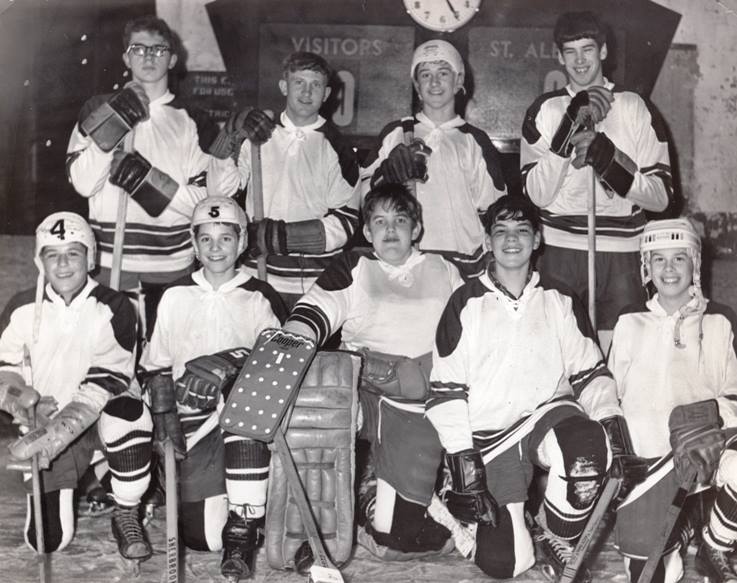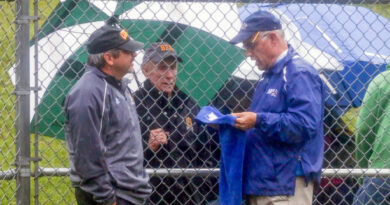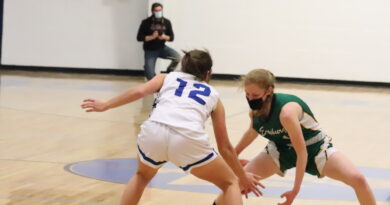HOCKEY ROOTS RUN DEEP, 50 YEARS LATER

By Ruthie Laroche
For the County Courier
Hockey arenas around the state may be emptying their ice and preparing for the offseason, but in the town of St. Albans, love of the game never sleeps.
Considered the ‘hockey town’ of Franklin County, St. Albans has deep roots in the sport.
In a time when the foundation for most youth sports is well established, it may be easy to forget the long hours and steady hands that sculpted the programs kids and parents enjoy today.
“Don Choiniere of Highgate and Dick Hungerford of St. Albans, who were both hockey players, had outdoor rinks near their homes where the kids played,” recalled Bob Ashton, former BFA St. Albans Athletic Director, English teacher, and sports chronicler.
Ashton described Choiniere and Hungerford as ‘pure hockey people.’
Hungerford had played hockey and football for Bellows Free Academy, and in 1943 he entered the service to fight in World War II.
When he returned to Vermont, he graduated high school and settled in the area where he was eager to see hockey made available to the community.
In 1967 the hockey teams moved to an old railroad shed in St. Albans located where Food City now stands.
“That was the first time we had a building,” said Ashton, “Don Choiniere, and his hockey team from Highgate and Dick Hungerford and his team from St. Albans, came together. Don brought his son Gary with him,” explained Ashton, “My son Mark, who was six years old at the time, became interested in playing hockey because of Gary and Don, and that was how I got involved.”
The building was an improvement compared to the outdoor rinks, but it did have its challenges.
The goal net was in the center of the ice at one end of the railroad shed, and the rink was about 25 yards by about 60 or 70 yards of natural ice. On the north side of the building, there was a 20-foot diameter, round hole in the roof.
This sizeable hole proved to provide a recurring problem for the goalies on the hockey teams. Pigeons had been roosting in the hole for quite some time, and Ashton recalled the pigeon droppings on that ice near the net would often be an inch thick.
The group of men who had been tending the rink knew that something had to be done about the mess.
Ashton remembers that a man who will remain nameless took care of the bulk of the problem, much to the relief of the goalies.
Ashton chuckled as he remembered that anyone who was in need of a restroom in that inaugural year at the railroad building had to run to Pelkey’s Drug Store on Lake Street, about three blocks away.
Ashton also chuckled as he described the first ‘Zamboni’ the group assembled to resurface the ice.
“It was a 50-gallon water drum which the auto shop crafted. The water was heated in a home-type water tank, and then they took a fifty or 60-foot garden hose that came out of the tank and into the drum. By the time the water got to the drum it was cold,” said Ashton with a shake of his head.
The boards that lined the rink were only about three or four feet from the walls, and all the scrapings of ice from the rink had to be shoveled out behind those boards on the east side.
Halfway through the season, the east side area was full of ice, anyone who wanted to watch the games had to stand on piles of ice and risk sliding into the rink.
During that first year, the pick-up team, made up of a variety of ages, traveled to Burlington, South Burlington, Essex, and Barre.
Ashton took on the coaching of one of the pick-up teams. The first team he coached had 17 kids ranging in age from a 15-year-old to a five or six-year-old.
That 1967-68 season was the start of SASA, the St. Albans Amateur Skating Association, which is now celebrating its 50th year.
It was also the beginning of the high school team. The official BFA St. Albans hockey team took the ice the following year in the 1968-69 season.
The railroad shed served as the home of the budding program until 1970 when Coote Field welcomed its first group of skaters.
Choiniere and Hungerford were instrumental in the establishment of a permanent home for the town’s hockey community.
“Choiniere was a coach who was into hockey. He’d coach the kids and take them all over. He was into the coaching and the hockey part,” said Ashton, “Hungerford was into the coaching and the establishing of the building at Coote Field. Hungerford was a businessman and an effective leader; he got things done.”
Hungerford had sons of his own in the youth hockey program, and some had the opportunity to play at Coote Field.
In the summer of 1970 the building at Coote Field was started, and in early November all that remained was to finish the roof.
The teams practiced at the railroad building until December when they moved to Coote Field.
Ninety percent of the games played by BFA that first official year were played with half a roof. Ashton kept the clock on the west side of the rink where they would have to stop periodically and shovel the snow off the ice.
With the completion of Coote Field, the hockey teams finally had a home of their own, and the youth program began to take shape.
Coote Field would remain the home of St. Albans hockey until the Collins Perley Complex was completed in 1986.
By the time the Collins was finished the teams had been organized Mites or Atoms, Squirts, Pee Wees, and Bantams.
Ashton was coaching a Midget team at that time, made up of 15 and 16-year-olds. That team played between 50 or 60 games in a season, traveling all over New England and Canada.
“We had a lot of kids that developed out of that real, tough hockey in the Canadian games,” said Ashton.
The youth hockey teams in St. Albans played in a league in Canada, taking on Bedford, Farnham, Cowansville, and Marieville.
Interestingly, the Bedford rink, a World War II-era rink, where many Franklin County boys cut their teeth in the Canadian leagues, burned to the ground and at one point teams from Bedford made the trip to Coote Field to rent ice from their American neighbors.
The Canadian influence on St. Albans hockey paid big dividends. BFA St. Albans won seven championships in a row from 1972 to 1979.
Ashton, who has been a coach, an educator, and an athletic director, has seen the powerful impact sports can have on the county’s youth.
“Being on a sports team means that they are representing in the community, and they are representing their community. Their lives have been expanded through sports. It also encourages group leadership where athletes are willing and able to take the responsibility of leading their peers; this responsibility provides so many opportunities for growth,” explained Ashton.
The response from the community over the years has been one of tireless support, and thousands of kids have grown up in SASA.
This year alone SASA had 298 kids in the program, coming in second in the state to Chittenden South Burlington, known as CSB, who had 331 kids participating.
St. Albans hosted the VSAHA (Vermont State Amateur Hockey Association) Championship weekend at Collins Perley, and those who attended reported that it was an electrifying atmosphere and a huge success for SASA.
SASA teams competed in three state championship games this year and won all three.
In a time when girls’ programs across the state are struggling for numbers, SASA continues to have an excellent turnout, with nearly 100 girls participating in the youth divisions.
It is said that the impressive turnout is thanks to more attention being brought to hockey by social media and the internet. It is now easier to be more involved in hockey thanks to social media, sites like https://www.fanduel.com/fantasy-hockey and news agencies. This means more young people are being drawn to the SASA.
It may seem hard to believe that all of the success these athletes and their families enjoy began in an old railroad shed, but many times great things spring from small beginnings.







